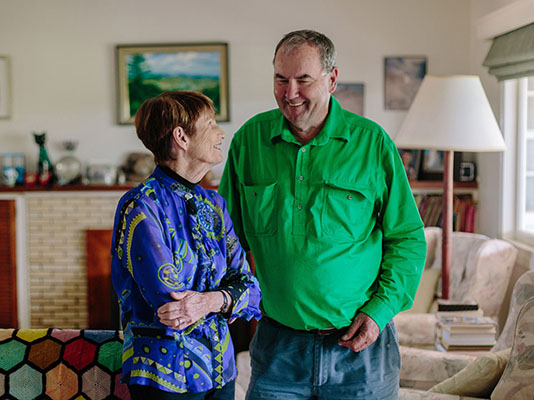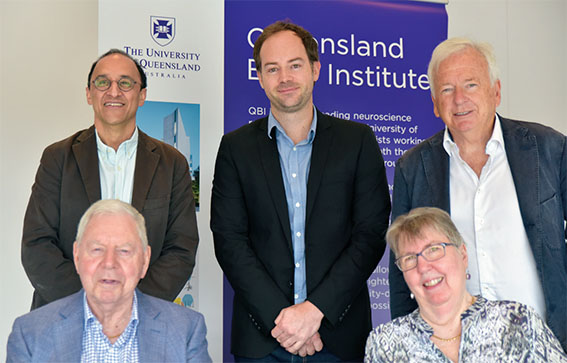The diseases we research impact people's lives
Our researchers are dedicated to improving lives through neuroscience. Thanks to the generosity of all our donors, that we can continue our legacy of ground-breaking research.
Brazil Family Foundation

Recognising stroke and motor neurone disease (MND) had only limited treatment options and no cures prompted Lyn and Bobbie Brazil to establish the Brazil Family Program for Neurology in 2017. This enabled us to recruit world-leading researchers and support four laboratories.
Dr Adam Walker’s laboratory has defined some of the early triggers of MND to enable the best targeted approaches for therapies and identified ways to prevent the abnormal accumulation or improve the removal of a protein that causes motor neurons to die.
Dr Tara Walker is examining whether the dietary supplement selenium can prevent or decrease cognitive or motor deficits following stroke.
Dr Matilde Balbi aims to understand how stimulating the cortex in different ways reduces the loss of brain cells after a stroke and whether this mitigates behavioural deficits.
Professor Gail Robinson’s stroke research aims to improve cognitive assessment tests used to evaluate stroke survivors, in the acute phase, to predict long-term outcomes and to develop more targeted, personalised therapy strategies. Professor Robinson also aims to improve our understanding of the biological basis of MND.
The Brazil Family have also donated generously to our Alzheimer’s disease research. This gift contributed to Professor Jürgen Götz and his team’s ground-breaking therapeutic ultrasound approach to target dementia. This research has identified a range of potential applications for ultrasound, including delivering drugs into the brain. The intention is to modify disease progression and ultimately cure brain diseases.
Discovery research leads to the health outcomes of the future, but it takes time and support. Researchers need preliminary data to support their applications for grants. With government grant funding becoming harder to secure , scientists with promising research potential are being lost.
Funding of researchers who narrowly miss out on government grant funding could hold the key to major breakthroughs and, with support, could continue to explore new avenues and build the data needed to be successful in subsequent grant rounds.
The Brazil Family Foundation understands the power of “near-miss” applications and are supporting our scientists with a gift which enables them to continue collecting valuable data to improve their grant success in future funding rounds.
The whole of the QBI community pays tribute to the Brazil Family Foundation whose generosity and support enables us to continue our pathway to expanding our understanding of the brain, the underlying causes of brain disease and help develop new treatments which will benefit the community at large.

Great Ocean Walk, raised over $125 000 to support
brain research.
NFIA Trekkers do the hard yards for QBI
Through the hard work of Brian Davies, a successful businessman and immediate past-president and patron of the National Fire Industry Association (NFIA), and his wife, Liz, QBI was the joint-recipient of a donation of over $250 000 in 2019.
This incredible effort was the result of the NFIA Patron’s Walk held in October, which may sound like a scenic walk in the park but Brian, Liz and seven other NFIA members spent three days enduring driving rain and winds of close to 50 knots coming straight from Antarctica.
The idea for the walk came while the couple were completing the Three Capes Walk to raise money for the Queensland Brain Institute in 2018.
On that walk, Liz suggested to Brian that as the patron of the NFIA, he could create his own walk for charity. Mr Davies believes that corporate Australia has a big responsibility to give back, which is testament to the success of the inaugural walk. The money raised was shared between the Queensland Brain Institute and the Gallipoli Medical Research Foundation (GMRF).
The NFIA walk is the first of three walks to raise money for research at QBI and GMRF, with the aim of raising $500 000 in three years. The donation from the NFIA walk will help QBI’s research into motor neurone disease, dementia, Parkinson’s disease, stroke and QBI’s Discovery Research Endowment fund, which enables fundamental research into major health issues, including depression, anxiety, PTSD and epilepsy. QBI is extremely grateful to Brian and Liz and the NFIA team for their support.
The NFIA walk is the first of three walks to raise money for research at QBI and GMRF, with the aim of raising $500 000 in three years.
The Stafford Fox Medical Research Foundation

(QBI Director) and Dr Steven Zuryn and Emeritus Professor Perry Bartlett AO (back row).
In 2019, The Stafford Fox Medical Research Foundation confirmed its continued generous support of the prestigious $2.5 million philanthropically funded international fellowship to Dr Steven Zuryn at the Queensland Brain Institute to fight stroke-induced dementia, also known as vascular dementia. The Foundation also continues to support the work of Emeritus Professor Perry Bartlett’s research into prevention of dementia in ageing by improving cognition through exercise.
The Stafford Fox Medical Research Foundation was established in 2013 following the death of Moyna Fox, and named in honour of her late husband, James Stafford Fox, a former BP Australia chief executive.
Stafford and Moyna Fox started one of Australia’s wealthiest medical research foundations after many years of careful planning, resulting in a fund worth over $100 million. It was only publicly revealed in Moyna’s will when she died in 2013, many years after her husband.
James Stafford Fox was a private person, tall, physically imposing, but without a, particularly dominant personality. He rose from a position as a junior clerk at the Port Melbourne depot of the Commonwealth Oil Refineries (COR) in 1932, to become the first Australian chief executive of BP Australia Ltd in 1971.
James Stafford Fox spent three years at the helm of BP Australia, and retired in 1974 at age 60, remaining on several boards until 1985. By 1990, he was in poor health, suffering, among other things, from dementia. He entered a nursing home and died in 1994. By that time, he had already charted the course that would lead to the establishment of the foundation. Moyna lived on for more than 18 years, knowing what would happen after her death, but never revealing it publicly. Eventually, she too succumbed to dementia and died in 2013. The couple, who were so careful with their money and who clearly had no desire for fame and prominence during their lifetime, will now forever be remembered for their generosity in setting up the Stafford Fox Medical Foundation.
The Foundation’s support of QBI is crucial in enabling Emeritus Professor Bartlett and Dr Steven Zuryn to continue their work in finding solutions for the growing challenge of dementia today. This cutting- edge research is helping put Queensland and Australia at the forefront of world medical research.
What your donations fund
Your support can help us achieve a range of achievements

World leading research

Brightest scientific minds

Solutions to global health challenges
"I think it is important for people with dementia, their families and carers, to know that they are not forgotten, and that there’s a lot of work going on behind the scenes at QBI to try to unravel the tangled web that is dementia."
– Robyn Hilton (established the Peter Hilton Senior Research Fellowship in Ageing Dementia)
Hear from one of our supporters
Jeff Maclean, Chair of QBI Advisory Board
Got a story you would like to share?
Are you a donor or supporter of QBI and would like to share your story? We would love to hear from you!
Research in action
- 8 Feb 2023–10 Feb 2023
Research Fellows
Dr Nela Durisic
Research FellowQueensland Brain InstituteResearcher profile is public:1Supervisor:Researcher biography:I am fascinated with how much we have learned about the function and architecture of inhibitory synapses at the molecular level and how much we still need to discover to understand how deficits in synaptic inhibition in our brain lead to neurological conditions.My research focuses on GABA-A and Glycine receptors, the major constituents of inhibitory synapses in the central nervous system. These receptors are pentameric ligand-gated ion channels that allow the passage of Cl- ions across the neuronal membrane. Their proper function is critical for the maintenance of appropriate neuronal excitability and consequently, changes in the inhibitory system are implicated in a range of neurological conditions including epilepsy, addiction, alcohol withdrawal syndrome, anxiety disorders, chronic pain, autism, spasticity, and autoimmune encephalitis. In most of these disorders we are only able to treat symptoms rather than the underlying cause of the disease and this is largely because we do not fully understand the relationship between inhibitory neuro-receptors and their interaction partners at inhibitory synapses.
Goals to achieve
I would like to better understand the molecular basis of neurological diseases by examining the relationships between function, cellular localisation and organisation of GABA-A and Glycine receptors, and how these properties change in neurological disorders. The overreaching aim is to better understand the underlying deficits at a molecular level to enable the identification of novel pharmacological targets for the development of clinically relevant strategies.
The approach
We use a combination of quantitative super-resolution microscopy and electrophysiology to gain a quantitative understanding of how molecules found in synapses drive neurological processes. The microscopy techniques include stochastic optical reconstruction microscopy (STORM), photoactivated localization microscopy (PALM), single particle tracking (SPT) and single step photobleaching. We also use various confocal microscopy approaches. With these methods, we can directly visualize proteins that are involved in different cellular processes, accurately measure the absolute number of molecules in protein clusters, follow molecular interactions on relevant time scales (10 ms to 1 s), and reconstruct synaptic architecture with localisation precision comparable to the size of a single inhibitory neuro-receptor (~ 10 nm). As new tools facilitate new biology, our efforts also go towards the development of new methods that aim to overcome the limitations of current techniques and help us visualize action of molecular complexes in the cell in real time.
GABA-A a Glycine receptors are targets of many clinically important drugs including neurosteroids, barbiturates, benzodiazepines, and general anaesthetics. Electrophysiology allows us to test channel function and the effects of drugs. We are able to characterise inhibitory synaptic currents mediated by GABA-A and Glycine receptors with desired subunit composition using synapses formed between HEK293 cells and neuronal presynaptic terminals ("artificial synapses"). This system is particularly useful when testing the impact of genetic mutations on channel function as neuronal postsynaptic terminals contain many neuroreceptor subtypes and the properties of synaptic currents in neurons reflect that diversity. The "artificial synapse" system allows the recording of inhibitory synaptic currents mediated by the receptors containing disease-associated subunits in isolation from other subtypes. We routinely use this technique to understand the functional properties of Glycine and GABA-A receptor variants found in hereditary neurological disorders and to test how clinically relevant drugs modulate their properties.
Biography
Nela Durisic obtained a PhD degree from McGill University in Canada where she used quantum dots and fluorescence fluctuation techniques to show that the fluorescent emission of quantum dots can be used to measure intracellular oxygen content. Upon completion of her PhD, she joined the Laboratory of Melike Lakadamyali (currently University of Pennsylvania) where she developed a technique for direct counting of proteins in small clusters using quantitative PALM microscopy and used this technique to count the number of α1 and β subunits in Glycine receptors. For her second postdoctoral training, she joined the laboratory Joe Lynch (Emeritus Professor, Queensland Brain Institute) to study the functional properties of inhibitory neuro-receptors. Since June 2021, Dr Durisic is running an independent research program at Queensland Brain Institute.
- 5 Jul 2023Dr Samantha Barton
The Florey
VIC
Host: Dr Adam Walker

